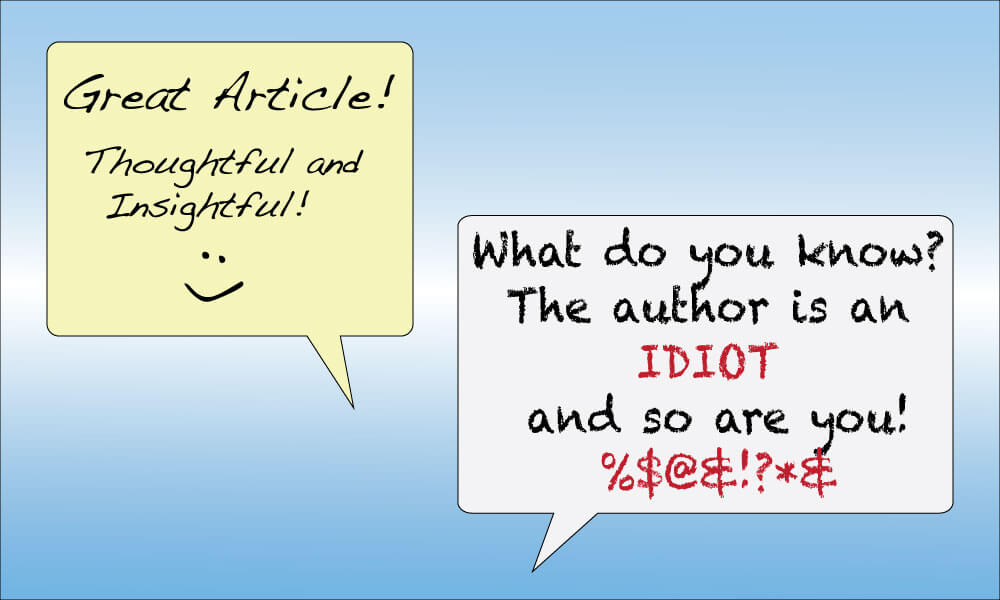Comments Section: Land of Constructive Public Discourse Or Playground of Trolls?
Whether creating a website or starting a blog, one of the important decisions to make is whether or not to include a comments section. The Internet, that glorious land of interaction and anonymity, has been idealized as an idyllic community where people engage in intellectual and creative dialogue to make the world a better place and solve each other’s problems. In reality, Internet interaction has a dark underbelly that too often takes over and ruins it for the rest of us.
There are many articles outlining best practices in design and set up of comments sections: no need to repeat here. Up for consideration is the usefulness of having a comment section at all.
First, let’s talk about the Pros of Comment Sections:
- Active Discussion
Comments encourage active discussion of your posts/site/products. This discussion brings your brand, product or writing into people’s minds, increases word of mouth and advertises your wares in front of a (potentially) larger audience. When this discussion is positive, intellectually stimulating and original, it can greatly benefit your site.
- Demonstrated Readership
Comments indicate readership: there is an audience for what you are doing! And they are involved. This is priceless.
- Feedback/Constructive Criticism
Comments can help you improve your material through feedback and constructive criticism. Other minds will give you new insight and help you tailor your offerings to your consumer audience.
- Reader Rapport and Loyalty
RELATED: Nine Must-Have SEO Tools
Comments, if the author (or moderator) reads and responds, can create a rapport with readers that inspires loyalty and establishes a great network of readership. Loyal, committed followers are the holy grail for Internet businesses.
- Growth
Readers’ interaction in the comments can spur return visits or more reader referrals, translating to growth on your site or in your following. When someone feels involved and has a positive experience, they are more likely to follow your site and more likely to recommend it to others.
Who wouldn’t want all that good stuff happening on their site? Including a comments section seems like a no-brainer. But don’t decide too quickly: we haven’t gotten to the cons! Pros and cons always go hand in hand.
Exactly what are the Cons of a Comments Section?
- Spam!
If there is an online receptacle, it will attract spam. There are easy ways to circumvent spammers, especially if you are thoughtful about setting up your comments section. But even with spam prevention, your comments section will require oversight.
- Necessity of a moderator
If you have a comments section, you will need a moderator. Preferably not the author of the site content, either, as much of the vitriol spewed by internet trolls will be directed at the one person willing to put his or her name on their work. Even if you have decided not to moderate the comments section, time and resources must be spent reviewing the content of the comments section, if only to eliminate any spam that eluded your spam prevention utility.
- Lack of comments
RELATED: Surviving A Critical System Outage
If you have a comments section on your site and it is unused or rarely used, it can make your content appear irrelevant or unread. All those positives above, like growth, active discussion, reader loyalty and rapport won’t happen if people don’t engage in the first place. If you are going to include a comments section, you may also want to consider how you will encourage people to use it.
- Negative, hurtful comments
If there are comments, there will be negative ones. If these comments were simply negative they could be ignored, but some comments will cross the line into downright nasty. And research has found that “insult-laden comments have the potential to change a readers’ interpretation of what they have read.” (We will talk more about this research in next week’s post.)
- **Flaming and TROLLS! **
Trolls rule the comment section. Jared Lanier, author of You Are Not A Gadget asserts that “trolling is not a string of isolated incidents but the status quo in the online world.”
RELATED: New Social Media Website Announced
Trolls are usually normal people like you and me, taking a moral vacation from their lives by flaming online. As Tom Postmes, a professor of social and organizational psychology at the universities of Exeter and Groningen explains: “Trolls aspire to violence, to the level of trouble they can cause in an environment. They want it to kick off. They want to promote antipathetic emotions of disgust and outrage, which morbidly gives them a sense of pleasure.” The anonymity of comments sections is the perfect environment for Internet trolls, and they take great advantage of it. The presence of trolls and the havoc they can wreak on a thread or for a website as a whole cannot be overstated and is perhaps the biggest thing to consider when deciding to include a comments section on your site.
Do not go lightly into the land of comments! Weigh the evidence for and against a comments section very carefully and consider the needs of your particular site.
Next week’s post will talk further on the research surrounding the efficacy of comments sections and methods for dealing with flaming trolls. Tune in!
*******
Emily Cantin researched, co-authored and created original artwork for this article.




